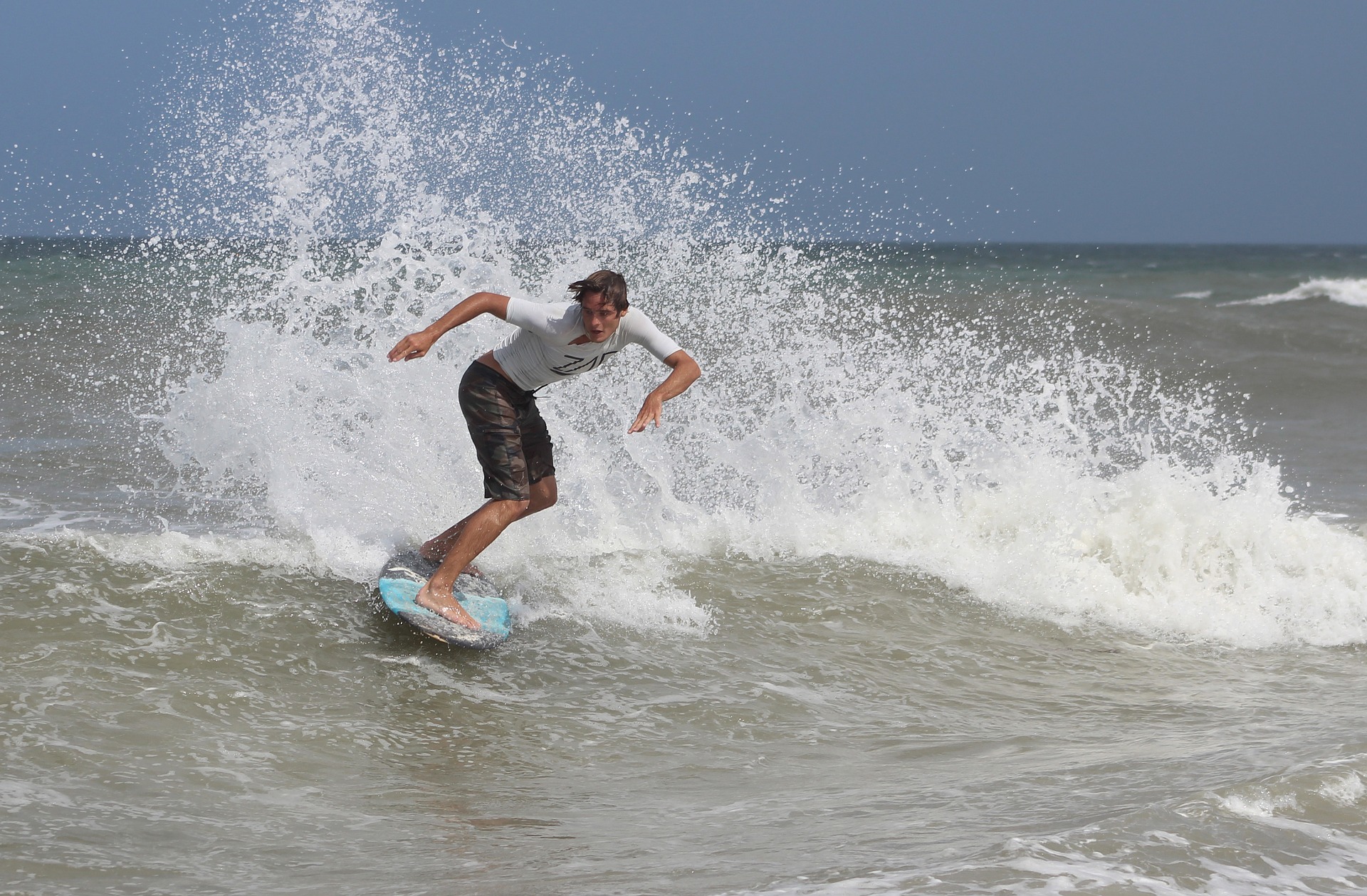Although both skimboarding and surfing involve standing on a board and riding over water, the two sports are fundamentally different.
Surfing takes advantage of waves generated by the ocean to propel a rider forward, this is usually done in deeper water and can include massive waves.
On the other hand, skimboarding is done in very shallow levels of water and is suited to waves that break on the shore.
Below we will discuss the similarities and differences of the two sports, where they can be done, and which will best suit your needs.
- 4 Similarities Between Surfing and Skimboarding
- 6 Differences Between Surfing and Skimboarding
- Which Is Easier To Learn?
- Do Skills Transfer Between Surfing and Skimboarding?
- Can You Surf With a Skimboard?
- How Far Do You Paddle Out With a Skimboard?
- Can You Duck Dive With a Skimboard?
- How Do You Catch a Wave With a Skimboard?
- Is Surfing or Skimboarding More Dangerous?
- Commonly Asked Questions
- 3 Tips To Help You Choose Which Is Right for You
- 1. Location
- You Might Also Like…
Disclosure: this post contains affiliate links (clearly marked with ), which means we may earn a commission if you buy something through them, at no additional cost to you.
4 Similarities Between Surfing and Skimboarding
As far as the two water sports go, surfing and skimboarding do not have many similarities.
1. Riding On a Water’s Surface
Both Skimboarding and surfing, at their core, are watersports where a rider uses momentum to travel across a body of water.
2. Conducted Standing Up
Although you will not always be standing up when surfing, both surfing and skimboarding are done in the standing position, with similar postures during the “riding” phase of the activity.
3. Material of the Boards
Both Skimboards and surfboards are primarily made from wood or fiberglass.
4. Location
The location of the two sports falls under both their similarities and their differences.
This is because skimboarding is often done at a beach where you will find surfers.
6 Differences Between Surfing and Skimboarding
As mentioned before, the differences between these two sports outweigh their similarities by a large amount.
1. The Board
When looking at a surfboard vs a skimboard it is easy to notice how different they are.
Skimboards are thinner, narrower, and shorter than surfboards.
Skimboards – unlike surfboards – do not have fins. This makes them harder to control when riding across the water.
2. The Location
Although these two sports can be done at the ocean, the locations differ in the way that surfing will always require the ocean (unless in a wave pool or river surfing), whereas skimboarding can be done on a lake, pond, or any other shallow water body.
3. Water Depth
Skimboarding is done in shallow water, often only a foot or slightly more.
Because of this, skimboarding is always done close to the shore, where the water meets the land.
Surfing, with the exception of dry reef surfing, is done in much deeper water, and therefore is, in most cases, conducted further off the coast (in some cases, like when surfing reefs, this can be kilometers away from land).
4. Waves
The fundamental of surfing is using the energy generated by a wave in order to propel a rider along the surface of the ocean.
This is what the sport is built around, and therefore cannot be done without waves.
Skimboarding on the other hand can be done both while riding waves as well as on a flat water surface (where ticks are often performed).
5. Body Positioning
Although when in the riding position, both surfing and skimboarding use the same stance, a fundamental difference between your body position across the two sports is that when skimboarding, you are always standing.
This is different from surfing, as the majority of your time is spent on your stomach in the prone position. It is only when riding a wave that a surfer is on their feet.
In other words: with skimboarding, you will almost never find yourself in a prone position paddling on your board – which is kind of the norm in surfing.
6. Weather Conditions
Surfing heavily relies on weather conditions.
Besides the fact that the sport requires waves, the direction of swell, currents, as well as the strength and direction of the wind will have massive effects on surfing conditions.
This is less true for skimboarding as there is no need for waves.
Of course, in strong wind conditions, it will be harder to remain standing on a skimboard, but the sport does not rely as heavily on these external factors as surfing does.
Which Is Easier To Learn?
As with any new activity, there is a learning curve.
Across sports, athletes will often argue that their sport is the harder one and it is difficult to determine what is true.
Keeping that in mind, there are a few factors that can be argued for the case that surfing is harder to learn than skimboarding.
These factors come down to fitness, body position, reading the ocean, and location.
Fitness
Surfing is often considered an intense workout, this is for good reason as the sport requires constant effort to maintain the best position in the water, getting past the waves, and generating speed to catch waves.
When skimboarding, you neither need to paddle to the back of a set nor do you need to constantly move around to reposition yourself.
This greatly reduces the amount of physical energy required.
Body Position
When we surf, the majority of our time is spent on our stomachs.
This makes surfing harder to learn as there is an added action: popping up.
Learning to correctly pop up on a surfboard and into a standing position creates one of the more difficult learning curves of the sport.
Skimboarding eliminates this challenge as the rider goes from a running position directly to standing on their board, therefore, no pop-up is needed.
Reading the Ocean
Reading waves, currents, and swell direction is something that takes practice.
Once a surfer understands the ocean, the sport becomes significantly easier.
Although it makes a massive difference, it can take a large amount of time to get into the flow.
This can make surfing a challenging sport to learn as timing becomes extremely important.
Knowing when to paddle for a wave, which waves to take, and when to begin duck diving are essential to a successful day of surfing.
As skimboarding can be done in flat water, learning the ocean is not as important.
That being said, many skimboarders choose to surf shore-breaking waves, in which case, an understanding of how these waves break becomes important.
Location
The difference in location requirements sets the learning curve of these two sports apart.
Setting aside that a surfer needs to paddle out into the ocean, the conditions of each location make all the difference.
It is only possible to practice surfing when there is an ocean with beginner-style waves available in close proximity to the surfer.
Furthermore, these conditions change, and therefore the locations that suit surfing are not constant.
As skimboarding can be practiced in the ocean with or without waves, on a lake, in a pond, or any other shallow waterbody, the availability of practice time is greatly increased.
More time practicing leads to faster learning.
Do Skills Transfer Between Surfing and Skimboarding?
As skimboarding and surfing are so different, many of the skills learned in each will be irrelevant to the other.
However, there are a few principle techniques and skills that are similar between the two sports, and therefore will aid you when moving from one to the other.
Balance
One of the biggest transferred skills between surfing and skimboarding is learning how to balance on a board, and furthermore, how to do this in water.
If you learn how to surf, balancing will come naturally on a skimboard, and this is also true the other way around.
Turning
When turning a surfboard or a skimboard, many of the principles remain the same.
It should, however, be noted that because a skimboard does not have fins, remaining balanced while turning will be slightly harder, but the core ideas remain similar.
Understanding Waves
This only applies when a skimboarder surfs waves.
However, if they do, this can greatly help their understanding of the ocean when surfing.
Although the waves are different (because they are shore breaking) the general idea of how a wave forms, as well as the ideal timing to catch a wave, remains the same.
Learning this will benefit surfing, just as how learning the ocean while surfing will benefit you as you learn to skimboard on beach breaks.
Can You Surf With a Skimboard?
If we look at the definition of surfing, the Cambridge dictionary provides the following explanation:
“The sport of riding on a wave on a special board.”
In this sense, it is possible to surf on a skimboard, although the method is slightly different from that of using a surfboard.
As you can see in the video above, skimboarders tend to run from the beach and jump onto their boards while timing a breaking wave.
If this is done correctly, they can turn as they hit the break and surf the wave back to shore.
That being said, paddle skimboarding does exist, and is much more similar to surfing.
However, it is still done close to shore as skimboards are not as buoyant, and therefore are more difficult to paddle with.
How Far Do You Paddle Out With a Skimboard?
Unless you are paddle skimboarding, which is not the conventional way of skimboarding, the rider does not paddle out into the ocean but instead will wait on the beach and run towards a wave as it begins to break.
This means that you do not paddle out when skimboarding.
That said, if the waves are slightly too far away to reach when running from the beach you may choose to paddle out to them.
If this is the case, only close-breaking waves will work.
If the waves are breaking further out than approximately double the distance that you can reach while running, it is best to use a surfboard.
Can You Duck Dive With a Skimboard?
Skimboards are lighter and less buoyant than surfboards, and therefore are much easier to duck dive with.
Duck diving on a skimboard uses exactly the same principles that duck diving on a surfboard uses, although – as you will not be paddling past the break – it is unlikely you will ever need to duck dive with your skimboard.
How Do You Catch a Wave With a Skimboard?
Although at first glance catching a wave on a skimboard may seem complicated and a near-impossible task, it is easier than you think when you follow the correct steps.
Following the steps below will set you up to catch your first wave on your skimboard.
- Start on the beach a few meters from the waterline.
- Wait for the ocean to flatten and become calm in between sets.
- Allow the first wave of the set to roll in and break.
- Watch the oncoming wave behind that (the second wave of the set).
- Without waiting too long, begin running to the ocean and drop your board on the wet sand (the wave should still be forming and unbroken in all areas).
- Jump on your board and glide (skim) towards the wave. Make sure to carry your speed through to the wave as you will need the momentum to turn as you hit it.
- As you hit the oncoming wave, bend your knees, drop your backhand down, and turn your board 180 degrees (transferring your weight slightly backward will prevent you from nose diving).
- Ride the wave back to the sand.
This maneuver on hitting the wave and performing a 180-degree turn is known as the wrap in the skimboarding community and is the simplest way of catching a wave.
It may seem difficult, but with the right timing, wave selection, and a bit of practice, you will be catching waves in no time.
Is Surfing or Skimboarding More Dangerous?
Both skimboarding and surfing can be dangerous.
Which of the two are more dangerous will often come down to the individual, the style they adopt, and the location.
In many ways, surfing can be considered more dangerous due to the added risks that are involved.
When surfing, you are at risk of:
- drowning
- sea life
- collisions
- currents, and
- the ocean floor (among others).
As skimboarding is done in very shallow water (usually less than knee-deep), the chances of drowning or being swept out to sea are smaller than when of surfing, although not entirely eliminated.
That being said, because skimboarding is done in shallow water, and often with large beach breaks, the chance of a rider colliding with the hard sand below them is very high.
This can lead to broken bones, concussions, and more.
Both skimboarding and surfing are dangerous, for some of the same reasons, and some different reasons.
In a case like this there is no need to compare which is more dangerous, but instead, weigh the possible risks and take evasive actions.
Commonly Asked Questions
You likely have a few questions floating around your head about skimboarding.
The following are common questions that many people ask before adopting the new sport.
Are Skimboards Cheaper Than Surfboards?
A surfboard will cost anywhere from USD 400 to over USD 1000, while skimboards will cost between USD 300 and USD 600, depending on brand and quality.
In conclusion, surfboards and skimboards are roughly the same prices when bought new, although it is always best to have multiple sizes of surfboards because of the changing conditions.
It is possible to get away with a single skimboard when learning, and therefore skimboards, in total could be the cheaper option.
Should You Wax a Skimboard?
Most skimboards are sold with traction pads. If you are purchasing a cheaper board, you may need to buy these separately.
With a traction pad, there is no need to wax your skimboard as the pad does the same job that wax will.
That being said, if you do not have a traction pad, or do not wish to use one, wax is absolutely necessary to prevent you from slipping on the surface of your board.
This principle is the same as it is when waxing a surfboard.
Do Skimboards Float?
If you put a skimboard in water it will float.
Although they are not as buoyant as surfboards, skimboards are designed to float enough to allow a person to skim along the surface of the water.
That being said, because they are thinner than surfboards, they will not support your weight as well as a surfboard does, which will make it harder to lie on a skimboard in the water.
How Do I Look After My Skimboard?
The most important thing to remember about maintaining your skimboard is to keep it out of the sun and rinse it free of saltwater.
Long exposure to sunlight can cause the resin that holds your board together to break down, while salt that is not rinsed off can cause your board to become brittle and crack.
If you are taking a break in between rides, cover your skimboard with a towel or put it in the shade.
Once you are finished for the day, wash your board with fresh water, the same as you wash your wetsuit and yourself after surfing.
Is Surfing or Skimboarding More Fun?
As with all sports, everything comes down to personal preference.
The only way to decide which is more fun is by trying both a few times and making up your own mind.
Both sports are fun and exhilarating, but remember everyone is different.
3 Tips To Help You Choose Which Is Right for You
When trying to decide whether surfing or skimboarding is best for you, the decision can be quite difficult as the two sports are so different.
If you feel that you need to choose between the two, the following tips might help you make up your mind.
1. Location
Your location should be the biggest deciding factor when choosing between the two sports.
If you do not live near the ocean, then surfing is not a good choice as you will massively limit the amount of time you have to enjoy your new hobby.
Furthermore, if you live by the ocean but there are very seldomly surfable waves, then skimboarding may be the best choice.
2. Swimming Abilities
Because surfing requires you to paddle out into the ocean, you should make sure that you are a strong swimmer before attempting to surf.
Skimboarding can be done in very shallow water, and therefore can be done when you do not know how to swim.
The only time this is not true is when skimboarding in the ocean, particularly when riding shore breaks.
Although you do not need to know how to swim, it is never a good idea to enter the ocean with no swimming capabilities.
Remember, the ocean is unpredictable and can be dangerous even in shallow water.
3. Fitness Level
Surfing requires a much higher fitness level than skimboarding.
If you are not particularly fit, surfing will become much harder.
That being said, skimboarding requires you to run to the water, and a large amount of core strength when balancing on your board.
Although this may be a deciding factor for you, it is better to raise your fitness level than choose between the two sports because of it.
Conclusion
Skimboarding and surfing are very different sports, although they do have some overlap when it comes to locations and a few of the fundamentals of riding over water while standing on a board.
Because the two sports are similar in some ways but so different in others, they tend to complement each other well.
Instead of choosing between the two, it is a great idea to practice both.
By doing this, there will always be some fun to be had, no matter what the conditions are like on any given day.
You Might Also Like…
-

Do Surfers Ride Switchfoot? 5 Benefits (& Why You Should Learn It)
-

Do Surfers Shave Their Legs? 5 Common Reasons (+Pros & Cons)
-

Do Surfers Wear Helmets? 8 Situations You Should Wear One (+4 Cons)
-

Do Surfers Poop in the Ocean? Myths & Facts (+5 Tips)
-
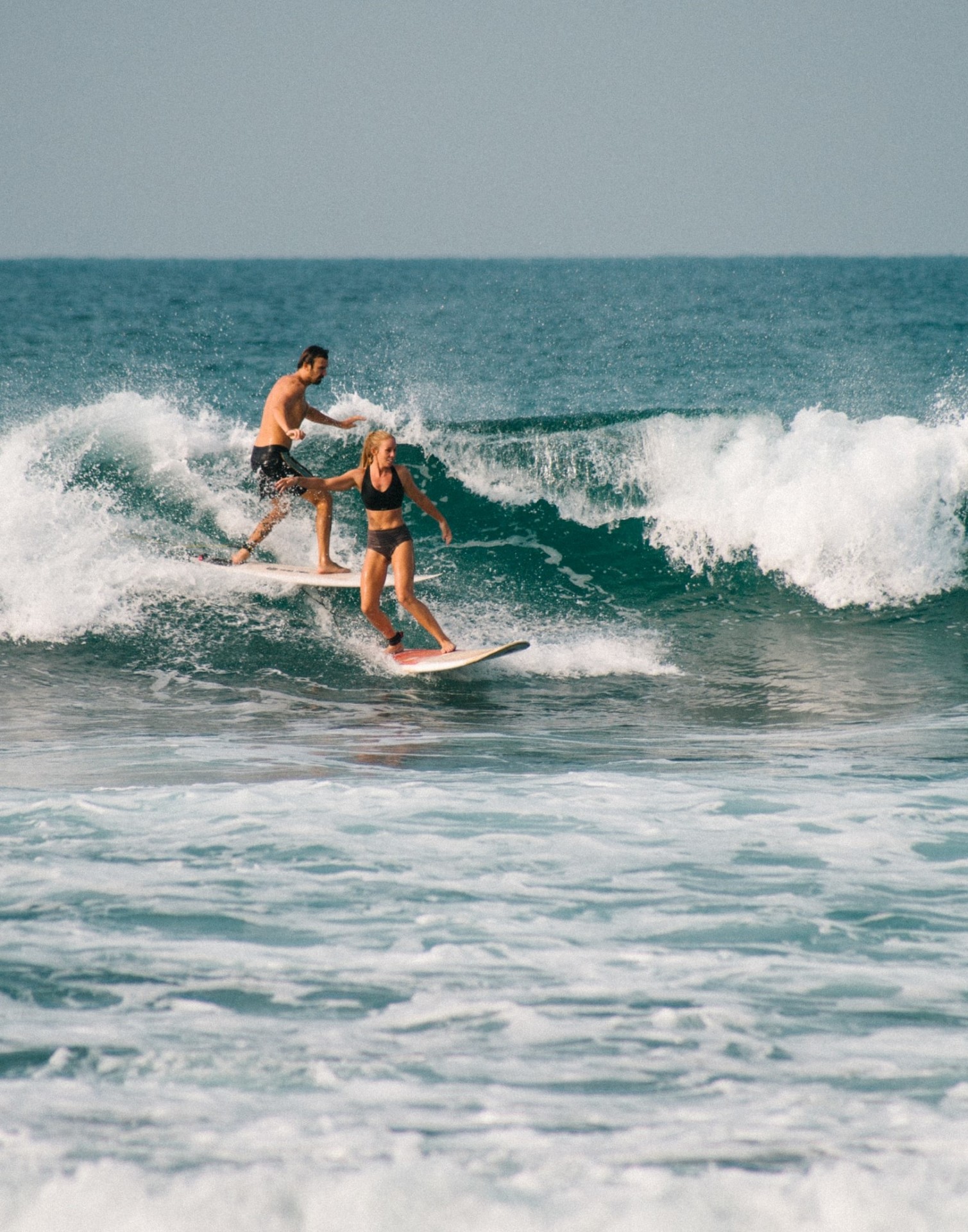
Do Surfers Run Into Each Other? 5 Common Reasons (+8 Tips)
-
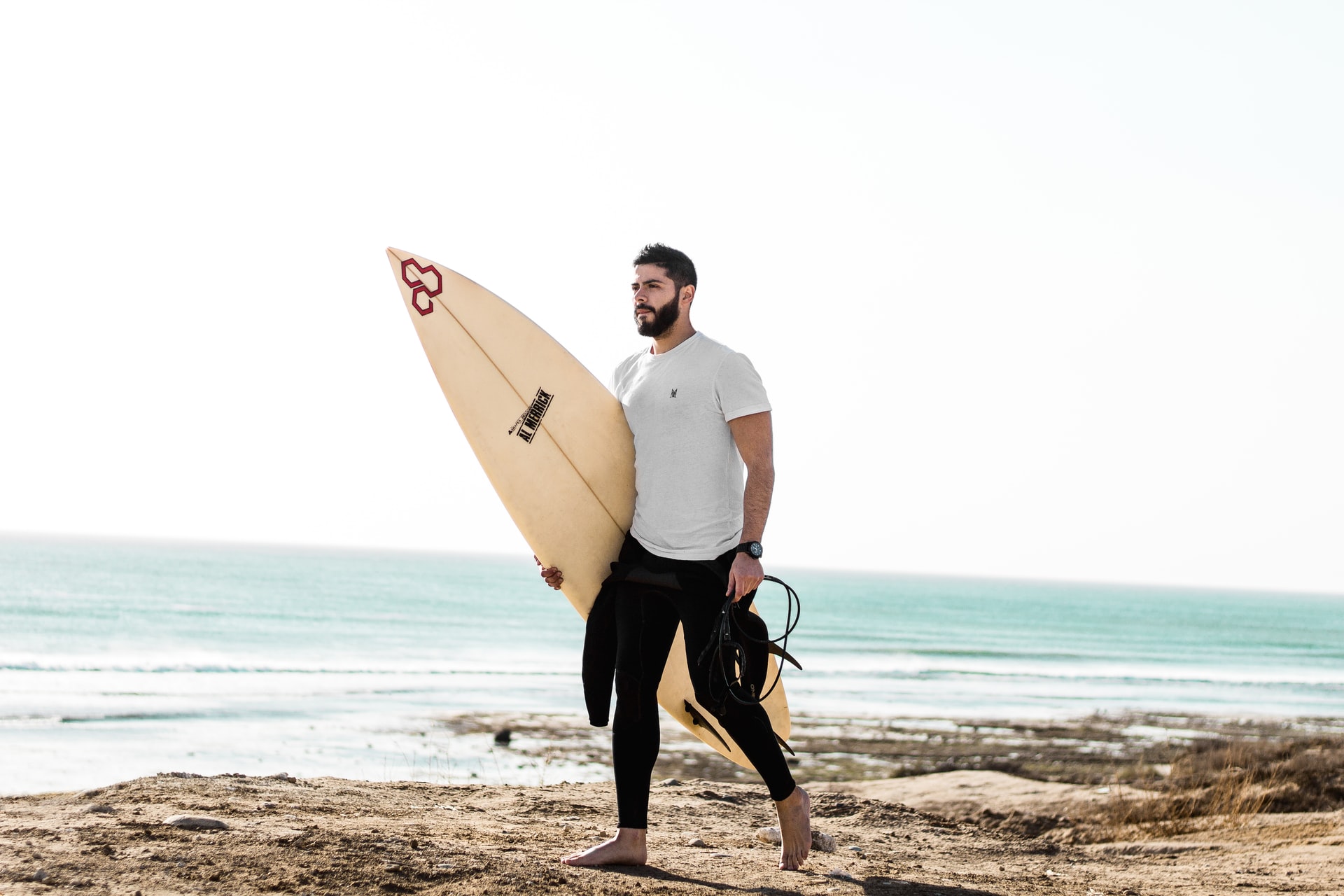
Do Surfers Have Beards? Pros & Cons You Should Know (+4 Tips)
-
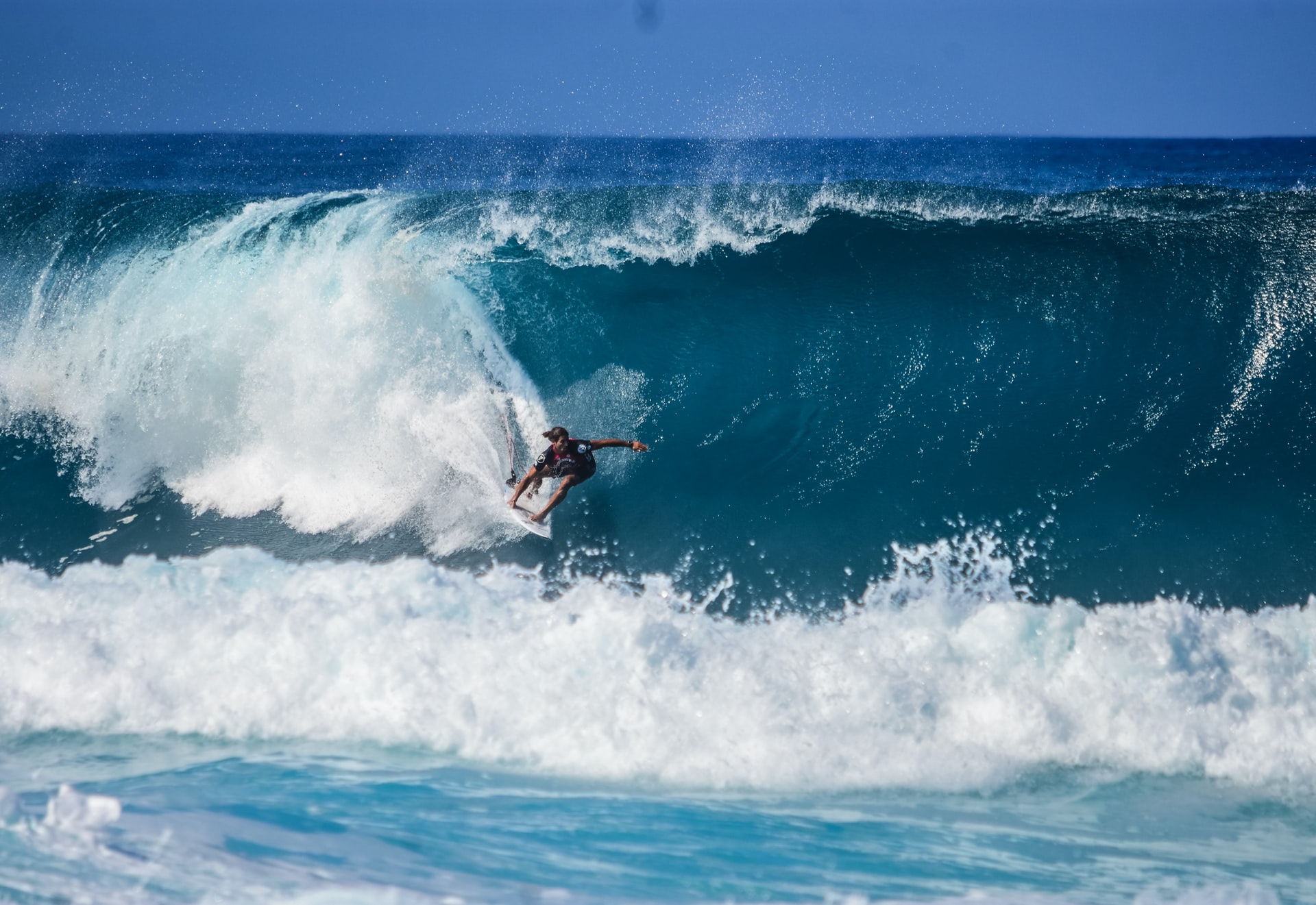
Do Surfers Like Constructive or Destructive Waves? (+Pros & Cons)
-
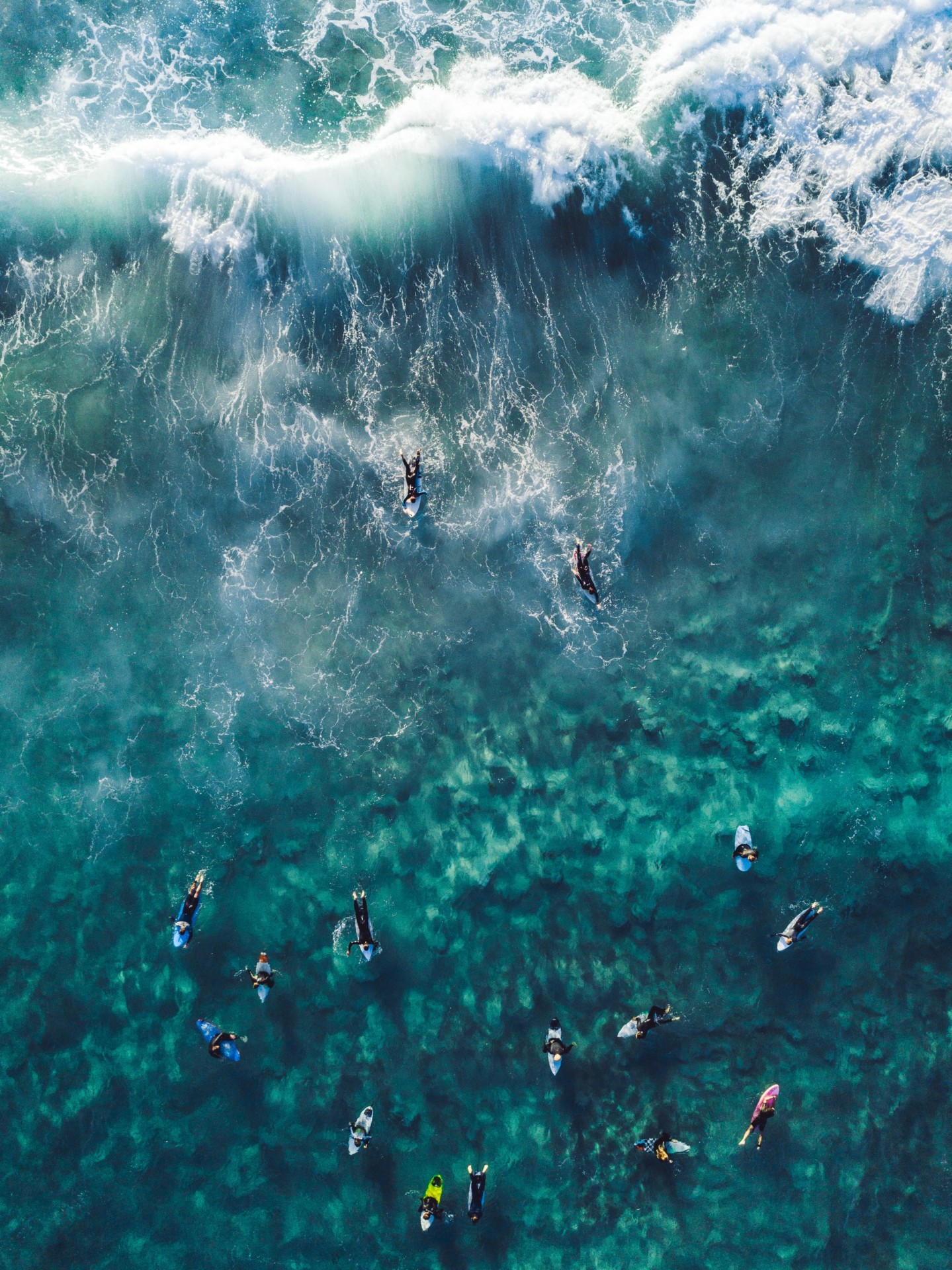
How to Surf Safely: 34 Crucial Tips (Every Surfer Should Know)
-
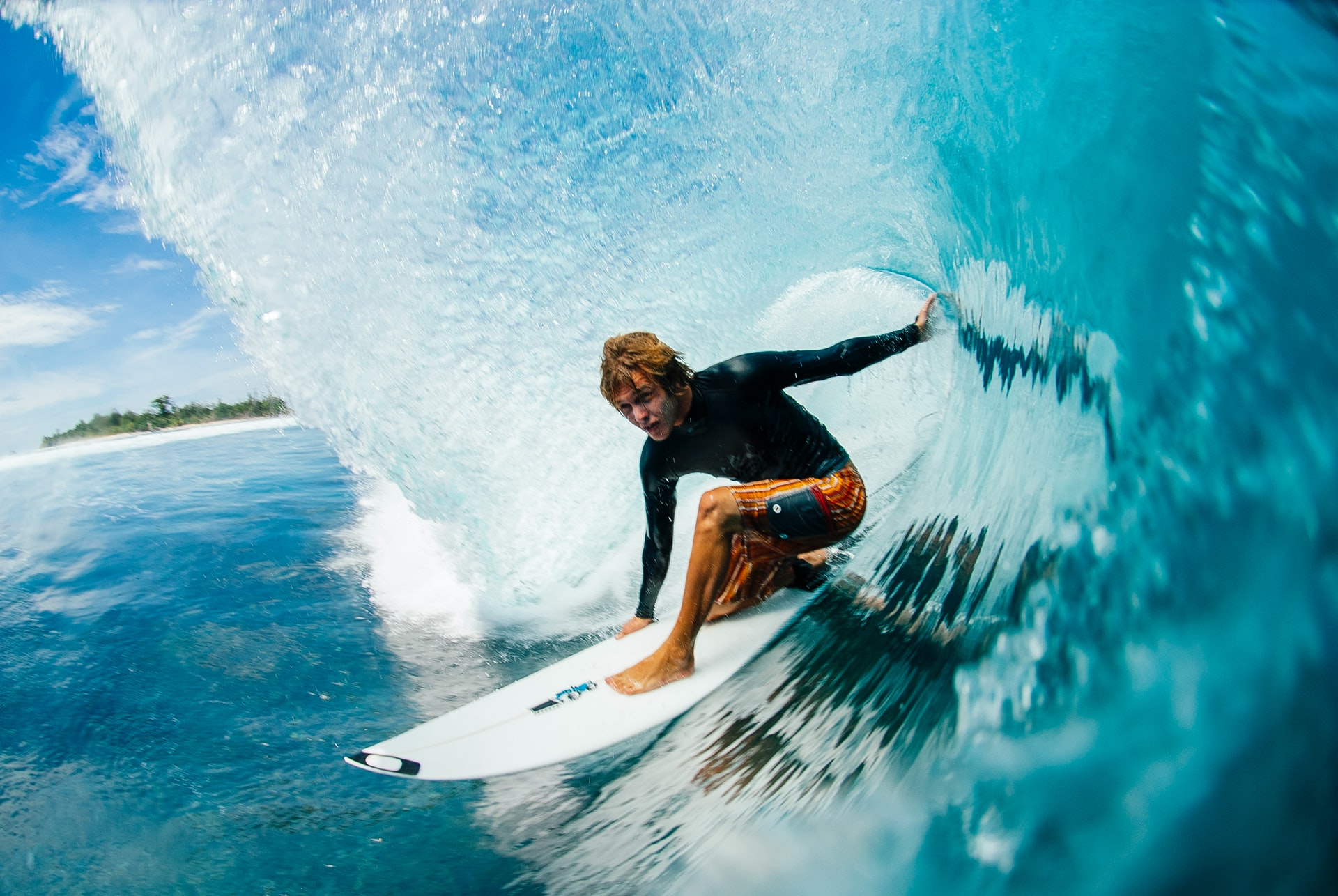
Do Pro Surfers Use Leashes? (+6 Reasons Why You Should Too)
-
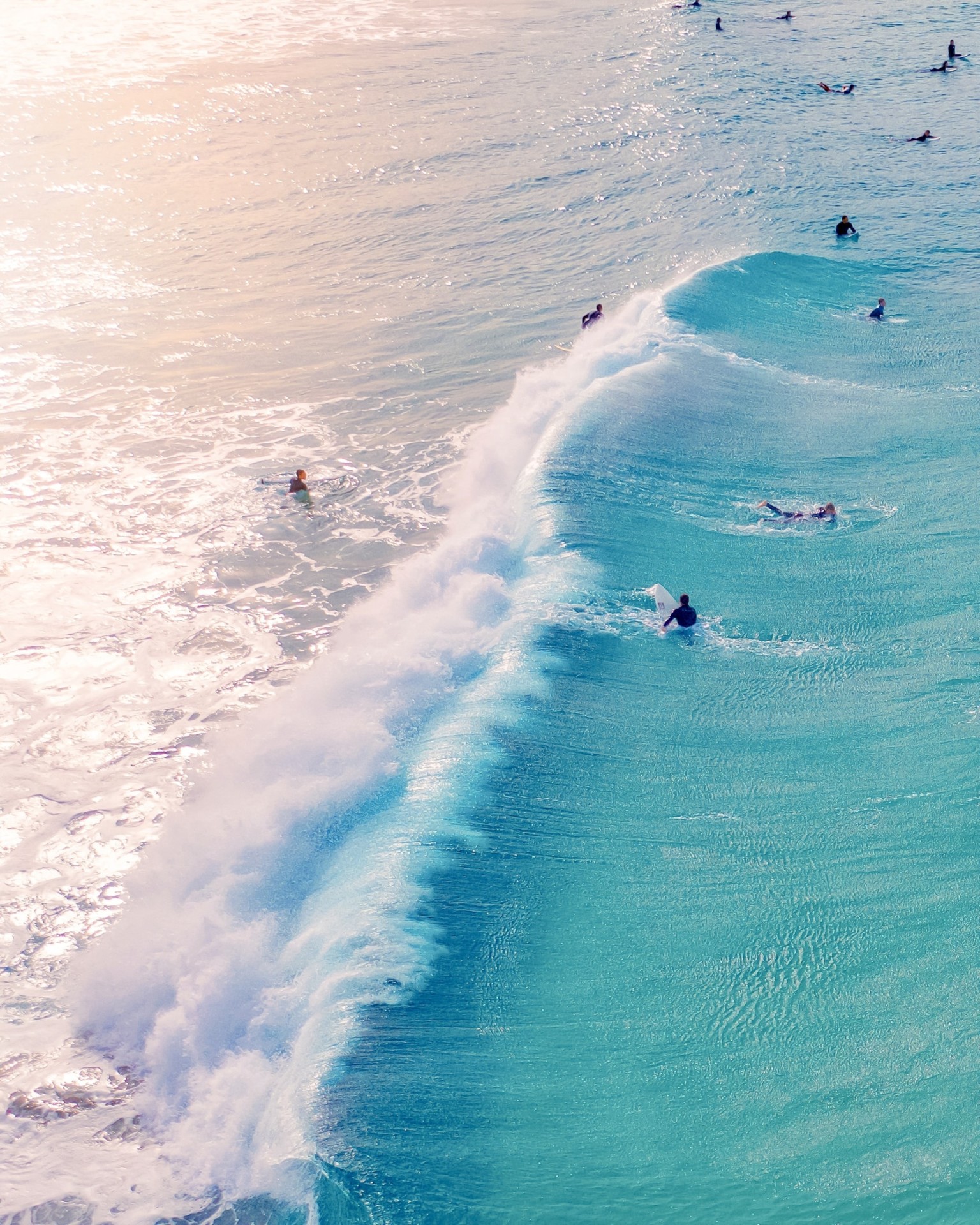
Do Many Surfers Drown? Here Are the Facts (+4 Common Reasons)
-
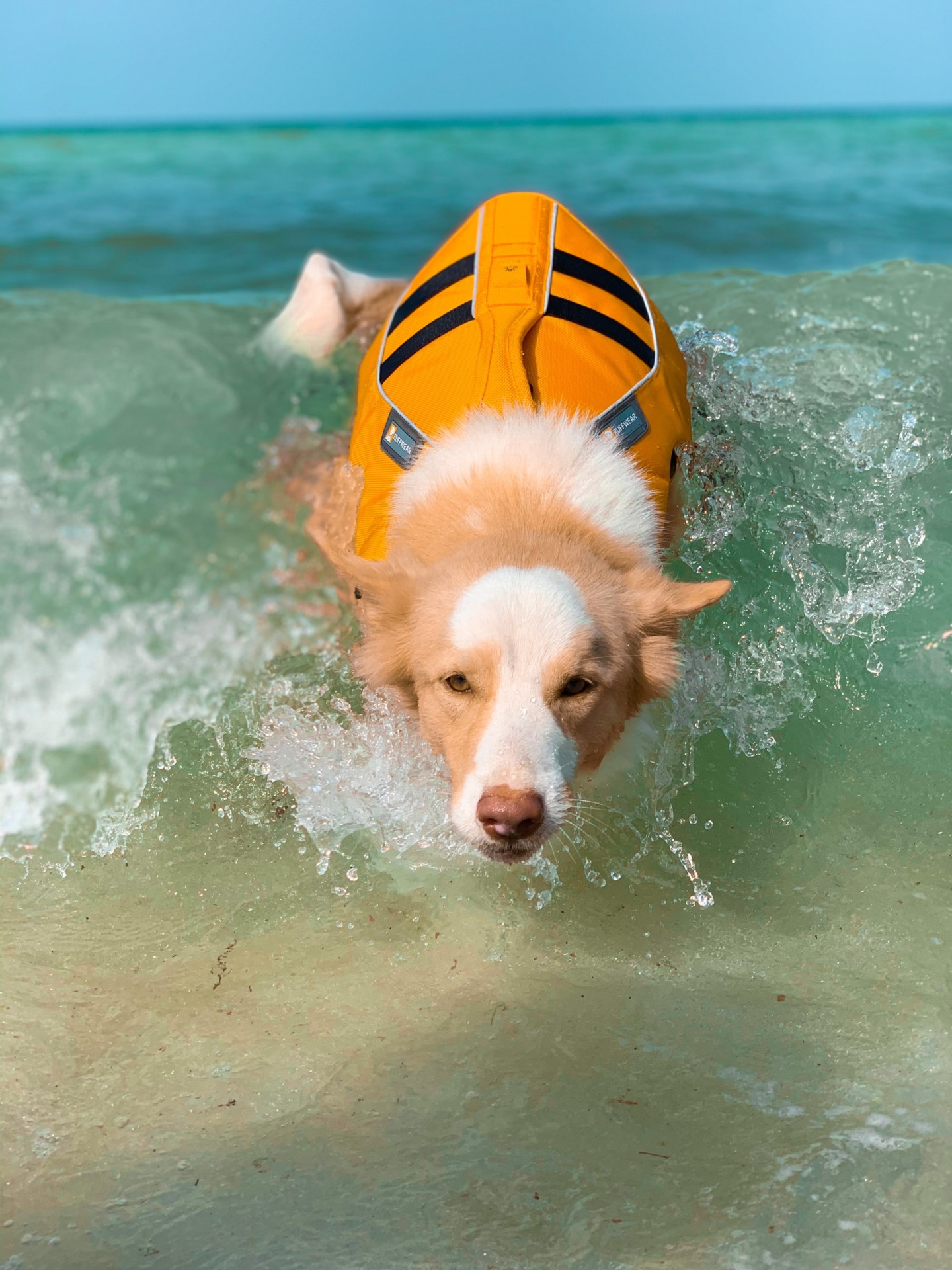
Do Surfers Wear Life Jackets? (7 Reasons Why They Don’t)
-
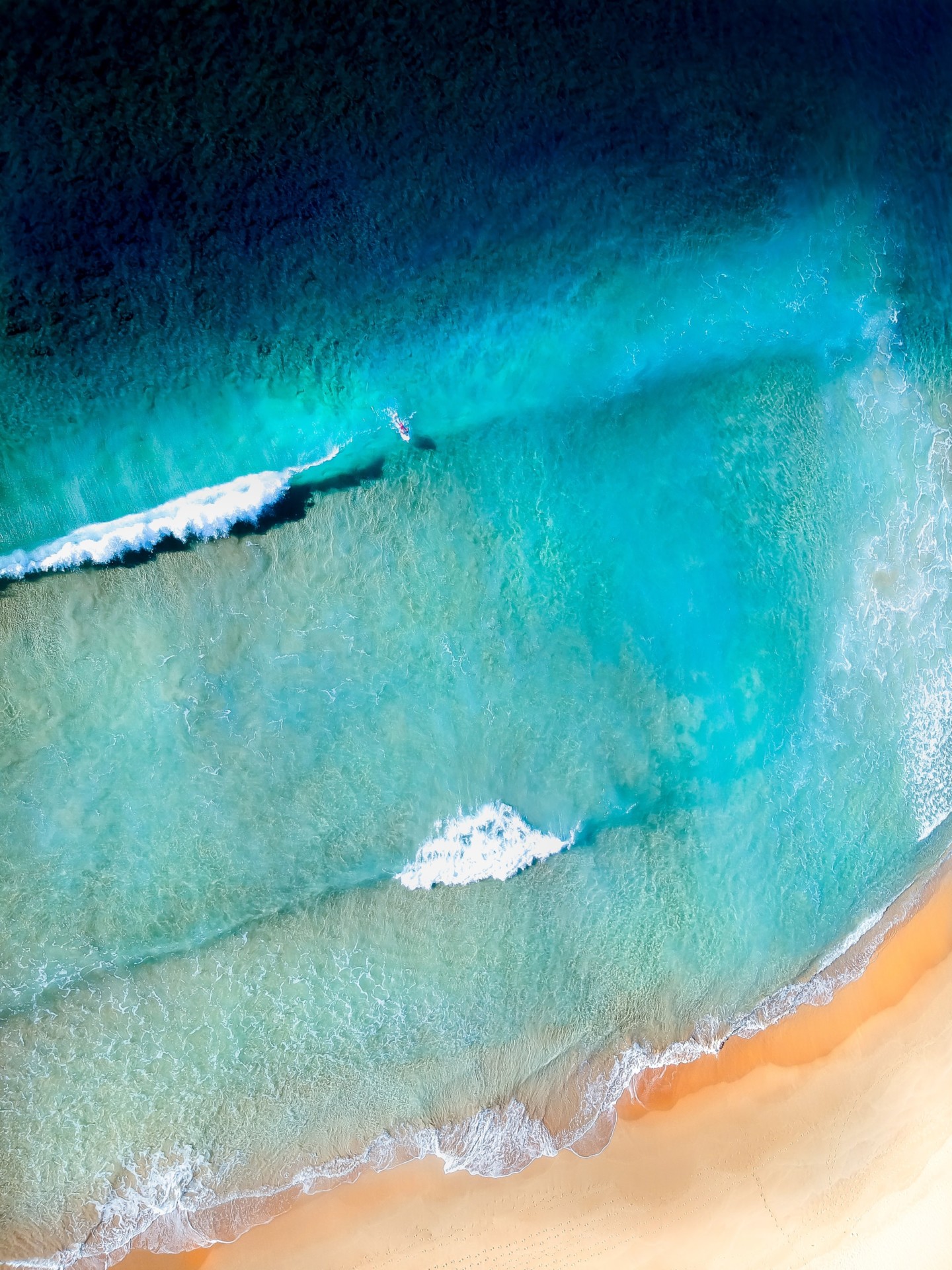
Do Surfers Like Rip Currents? (& How to Use Them Safely)

